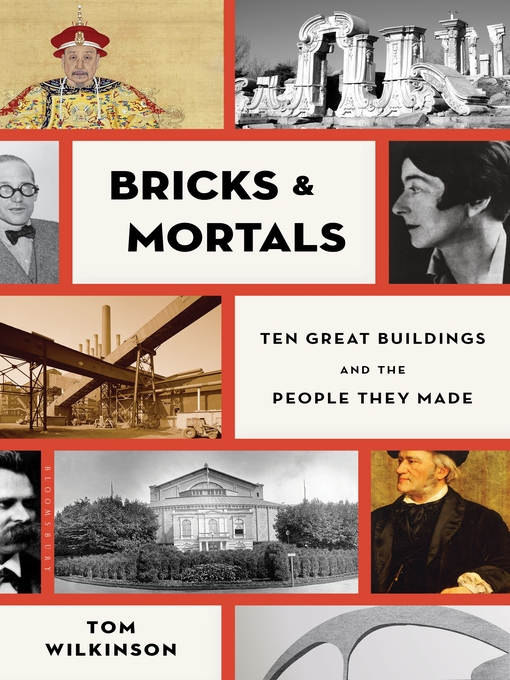In this book, ten buildings from across the globe tell stories of architecture from the beginning of civilization to the present day. From the remains of the Tower of Babel to the Summer Palace in Beijing, built and destroyed by Europeans, to the Ford car plant where the production line was born, Tom Wilkinson unpicks these structures to reveal the lives of the people who built and used them. Architecture has always had a powerful and intimate relationship with society and the lives of those who build and live with it. It has often been used to try and improve society. But can architecture change our lives for the better?
The buildings are: the Tower of Babel, Babylon; Nero's Golden House, Rome; Djinguereber Mosque, Timbuktu; Palazzo Rucellai, Florence; the Garden of Perfect Brightness, Beijing; the Festival Theatre, Beyreuth; E.1027, Cap Martin; Highland Park Ford Plant, Detroit; and the Finsbury Health Centre, London.
-
Creators
-
Publisher
-
Release date
July 22, 2014 -
Formats
-
Kindle Book
-
OverDrive Read
- ISBN: 9781620406311
-
EPUB ebook
- ISBN: 9781620406311
- File size: 10315 KB
-
-
Languages
- English
-
Reviews
-
Publisher's Weekly
April 21, 2014
Wilkinson takes readers on a lively tour through the ages by studying 10 world-wide architectural wonders. From ancient Babylon’s Tower of Babel, to a mercantile palazzo in Renaissance Italy, to a footbridge in contemporary Rio, Wilkinson focuses on what makes each structure specific to its time and place. Broadly exploring how architecture “shapes people’s lives and vice versa,” he uses each selection as a springboard to discuss the themes evoked. Designer Eileen Gray’s villa on the French Riviera, built in the 1920s for her lover, leads to musings on buildings and sex, while Henry Ford’s car factory in early 20th century Detroit connects architecture with mass production, and Nero’s Golden House inspires a thought-provoking discussion on the morality of architecture (Can a structure built by a bad ruler be good?). Concluding that today’s biggest challenge is the fact that the 21st century urban world “squats in squalor,” he urges political change, with architecture that benefits people, rather than “the developers, speculators, and corrupt bureaucrats who profit from it.” A witty, erudite narrator not shy about inserting his opinions, Wilkinson draws on his extensive knowledge of art, literature, history urban planning, sociology, and culture to explore the intimate relationship between architecture and society. Illus. Agent: Annabel Merullo, Peters, Fraser, and Dunlop (U.K.) -
Kirkus
June 15, 2014
A lively combination of scholarship, cultural history and sharp-tongued social commentary about our buildings-what we use them for and what they reveal about their designers and about us.Wilkinson, who has lectured on the history of architecture at various academic venues in England, Germany and China, begins with a simple hut-surely the first human habitation-and ends with a "curvaceous footbridge" in Rio de Janeiro. In between are his investigations and ruminations about specific sorts of architecture developed for specific purposes-for the powerful, for religion, commemoration, entertainment, work, medicine and others. In each section, the author focuses on a specific structure, provides its history, tells us about its designer (when this is known) and describes its evolution and/or fate. But Wilkinson does much more than this. He also riffs on aspects of the building, its architect or purpose that he finds most compelling, and he manages to animate readers in the process. In some cases, he will probably anger some readers. He is manifestly liberal and humanitarian in his political views, so terms like "religious wing nuts," broadsides at Ayn Rand and descriptions of buildings (Henry Ford's factories) that are like machines "for squeezing the maximum profit from the workers inside" will not endear him to some of his readers-though they will certainly delight others. The author includes a fascinating chapter about Le Corbusier and his passion for a house designed by Eileen Gray-a house much damaged, writes Wilkinson, by Le Corbusier's murals (added later). His is a sad portrait of the house's decline and its very slow restoration. The author punctuates his text with bright, varied allusions to Hawthorne, the Marx Brothers, Wagner, Nero, Brueghel and the 1959 "kitchen debate" between Khrushchev and Nixon.A scholarly but swiftly flowing text that glistens with attitude.COPYRIGHT(2014) Kirkus Reviews, ALL RIGHTS RESERVED.
-
Formats
- Kindle Book
- OverDrive Read
- EPUB ebook
subjects
Languages
- English
Loading
Why is availability limited?
×Availability can change throughout the month based on the library's budget. You can still place a hold on the title, and your hold will be automatically filled as soon as the title is available again.
The Kindle Book format for this title is not supported on:
×Read-along ebook
×The OverDrive Read format of this ebook has professional narration that plays while you read in your browser. Learn more here.


